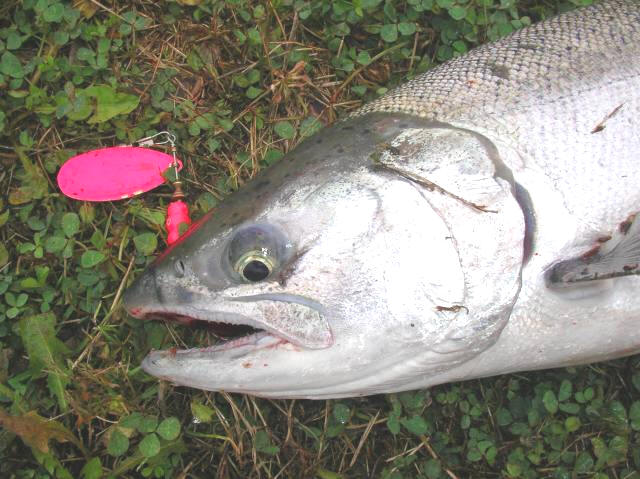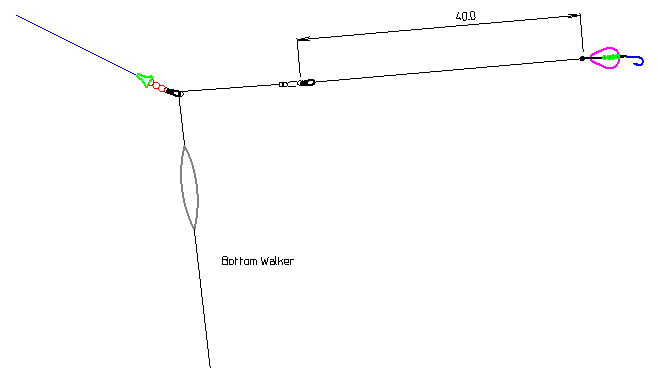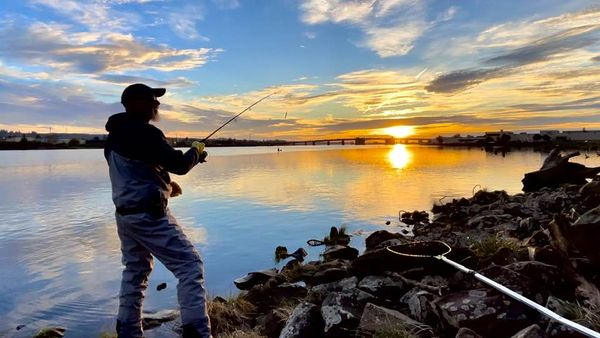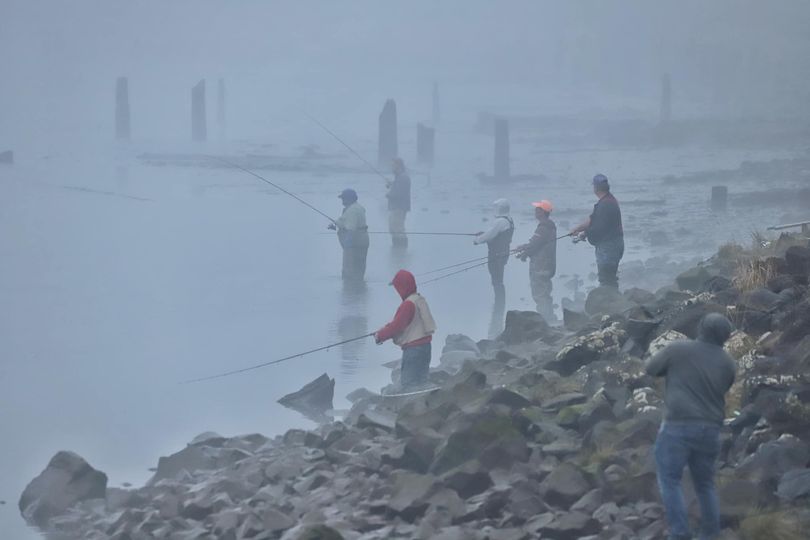Chehalis River Salmon
Fall Fishing in
Lower Section - 1

|
Chehalis River Salmon
Fall Fishing in
|
 |
The legal WDFW description of the Chehalis
River is that it starts at the upper boundary of Grays Harbor bay, which is the Hiway 101 bridge at Aberdeen. This fishery will be for Chinook and Coho
salmon which will usually be centered around the
waters from Cosmopolis to Montesano. However be sure to read the
WDFW regulations as some years the Chinook retention is closed if there appears
to be not enough returning wild fish for natural spawning escapement.
This article will cover from the Highway 101
bridge in Aberdeen up to the Montesano boat launch.
As stated in the 2005 WDFW regulations "All salmon
required to be released may not be totally removed from the water, except
anglers fishing from boats 30 feet or longer as listed on either their state or
Coast Guard registration are exempt" from this rule.
There are 3 launches in this
area. Here is the spot to use your car-topper or small 12-14' boat
with a 7 1/2hp motor, as compared to your 22' ocean fishing machine. You
are upriver enough and protected by the surrounding land that even a more than
mild wind does not effect the water that much.
Most of the fishing here will be from boats, as
bank access is limited, and just the conditions of tidewater banks is not
conducive to bank fishing unless you get upriver, use the facilities at
Friends Landing or above the Montesano launch.
(1) Weyerhaeuser Boat Launch - Chehalis River-- Cosmopolis
In Cosmopolis, turn east at 'F' Street, (
between the gas station and the
police station) go 2 blocks
to end of street and the parking lot.
Single lane blacktop ramp, with an
extra wide gravel side extension on upstream side. Sizable amount of
parking and it's usually pretty packed during the rush season.
Fairly good to launch during low tides.
No fee. No restrooms but no restrictions as to size of
boat or tides.
|
Weyerhaeuser Boat Launch at high tide - Cosmopolis |
Weyerhaeuser Boat Launch at moderately low tide, where you can see the high tide debris left on the ramp |
 |
|
(2) Friends Landing -
Originally owned by Trout Unlimited,
now run by
The Port of Grays Harbor.
For a link and history of this facility
CLICK HERE.
From Montesano, Chehalis River,-- West 1
mi on US 12; R and over Highway, then (south) on Devonshire Rd, go 1.1 miles South on Katon Rd 1.4 miles to
launch/recreation area. Single lane concrete ramp, $3.00 launch fee,
large gravel parking lot. The ramp goes down a lot further and it doesn't
just drop off when you do come to the end. No problem launching
during regular low tides, not sure about a super low tide however. However
you may encounter mud on the lower end of ramp at a low tide. Probably not
a good thing for launching/recovering a larger boat.
Portable restrooms with picnic areas, and public
fishing shacks, but no docks.
There is a groundskeeper and camping
areas available.
|
Friends Landing launch, during a high tide, & after heavy rains as you can see the HIGHER flooding tide debris here |
|
|
(3) South Montesano (WDFW) - Chehalis River
From Montesano, South on SR 107 .8 mile Left at
"Public Fishing" sign, go past the lumber mill, thru their
parking lot and .2 mile to end of Rd under bridge. No
Fee if you have a fishing access permit.
Double lane concrete ramp, lots of paved
parking, but the ramps can be a problem at low tide with a drop off on the
downstream ramp. As
long as you have the water, you shouldn't have any problems launching and
pulling out. But stay away from there during extreme low tides,
As of early September of 2016, this launch area was
completely rebuilt and is now a very good launch. However it is so
popular that you had better be there early to get parking.
Commercial Fisheries Here Also ; There can be both tribal and non-tribal commercial gill netting take
place in this section and below. For a link to the Quinault tribal dates
CLICK HERE. For the
link to the non-tribal netting dates
CLICK
HERE.
When ;
This fishery
usually starts October 1st when the season opens and runs thru November, depending on the rains,
which govern the fish's migration. Ideally we will get
1/2" or so of rain a day spread over 2 or 3 days and then drop down to
1/8" for a couple of days. This will be ideal in it starts the
fish into the river but not enough to allow them to migrate far upriver.
This kind of holds them in the fishing areas accessible in the lower river for a
while until the next rain.
Also the weather will dictate IF you
can fish. You may not be as concerned with the weather itself, but if we
get RAIN enough that raises the rivers to the point you are plowing
mud. Or the water is high enough that it is near a mild flood stage that
logs and other debris are coming down the river. These conditions
put fishing out of the equation for a few days until things calm down.
Tides ; The tides here do not seem to be as critical to fishing as in the lower part of the river, as the fish have moved into this area and are making their way upriver. However most fishermen do try to fish the incoming tide.
The tide here in relationship to the ocean tide, on an average,
Low tide + 2
hours 20 min. High Tide + 3 hours 10 min.
Tidewater influence under normal conditions, is
usually about a mile or so above the mouth of the Satsop River.
Where
; This fishery is still in tidewater and the water
will have some turbidity, with more on the high tide, especially one that
has a high run-off. In this lower section of the Chehalis, the effects of
upper tidewater ends at just below the mouth of the Satsop River.
Most of the trolling will be in the
section from the estuary up to the Montesano boat launch. Above that, you
should consider a jet sled as at low tide, rocky bars and submerged logs tend chew up props for the
newbie to the area (been there-done that). The casters from boats also tend to fish this same
area. While the bank fishermen will be found where ever they can gain
access. However you will catch the fish where the fish are, so
if you do not connect in one location, move to another.
A suggestion here if possible is to use a depthfinder that has a side-finder
option. This will allow you to "look" into an area of the water
without spooking them in this shallow water. Here is the ideal location to
use that Bottomline Fishing Buddy unit you got for Christmas. With it you can
scan a likely looking area for fish, if there is none, then move on to another.
The bend above the Montesano launch is
(below the saw mill) about as far upriver you will want to go at low tide with a
prop boat at anything other than high tide, as the river starts to get some
shallow gravel bars and down trees in the river. The water can be
murky enough that you can not see the gravel bars, so you have to either run
aground a few times or soon learn how to read the water. Don't think that
how the river was a year ago is what it will be today, as winter floodwaters can
change things.
Here the bank fishermen
use the rip-rap northwest bank just above the sawmill. They park at the
parking lot at the old log yard next to the freeway and walk the 100 yards to
this area or pull into the next road and drive right to the rivers edge.
If you limit out on salmon, or they are not in this area at
the time you try, you can always anchor up and sturgeon fish, (if the season is
open) as this area is
also good in this respect.
Hooks ;
The law says single
point barbless hooks. Here things get a bit confusing so if you are using some of your old spinners or you just bought
a spinner with triple hooks, it appears that you are going to have to replace them with a
single Siwash
hook, however the regs say up to three per line. Now ponder this, is it
legal to attach TWO single Siwash hooks back to back on a lure?? And remember to pinch the barb down to make it a
barbless to be in WDFW compliance.
3 Different Types of
Fishing
; You
will probably see more trollers here than casters, but both can be
effective. This is a small boat show, with many car toppers up to about
18' max. Many trollers will change to casting as the tide nears slack
time.
Trolling ; Early October right after the first rain.
It is suggested that you at least make a run in your intended fishing area at
low tide to get some mental or digital pictures of underwater logs, debris
etc. This will give you an edge as to know where to find the fish
and also where to avoid if it looks like a place that you will loose lures
often.
The most productive areas will generally NOT
be in the center of the
river. For one, this is where all the boat traffic is, this can spook the
fish. These fish will tend to stay close to anything that they can feel secure
near, as piling, logs, etc. This then equates to fishing near the piling
and or shore lines. The water depths here in the
main part of the river will vary from 25' to 60', but you may encounter some
underwater debris and logs in some of this section. There is one
log/logs etc. that I would like to find a diving friend and have him try to
recover all the lost gear on.
Troll in shallower water, (deeper water also dilutes your bait's saturation), in 16' of water, your lure is covering more fishable water than if it was in 40'. This is not to say that don't fish the deeper water, but if you do, have one person fish deep
and if another person is aboard, have them fish shallower.
Here in this section of the river, you will have to be ever observant of underwater possible snags.
If you are fishing near the bottom, it is best to NOT use rod holders, so you can raise the rod tip to clear underwater snags as soon as they are felt by your sinker
/ dropper.
It
is best to run say 65# braid mainline, 60 or 80# extension in front of the Fish
Flash and 40# leader. This line ratio pretty well guarantees you will not
loose expensive gear, but is strong enough to horse a Chinook (if that season is
open) out of the brush. Use a lighter mono (10-12#) as a sinker dropper so WHEN it hangs up, this lighter
mono will break before you loose your other gear. Have many 18" droppers pre-tied. Use lighter sinkers (2 to
4oz cannon balls) here as compared to the John's River
type fishery.
The water is not usually running as fast and the lighter sinker allows you to fish slightly higher off the bottom,
and at a longer line angle therefore cutting down on possible
snag-ups as the sinker dropper will slide up and over easier than if at a
steeper angle. You can change the sinker weight as the current changes with the tide.
There are a few snags on the bottom here, some you do not know until you hand up on them. One thing I found to help eliminate chances of snagging up is to purchase the "Bottom Walker" weighted wire unit designed for Walleye fishing as shown on the bottom below. This seems to function quite well for fishing of this type. And when the walker's bottom wire hits something, the walker rides up and over and at the same time the shorter upper end of the Ell pivots and also raises the lure. With this you can actually drag the bottom, placing the lure in the fish's face. Recently, I found another version of this walker that works quite well and that is to cut off the rear Ell of this walker, then attach the upper eye into a sinker slider on your mainline.
Also here it
is best to use a heavy enough weight so that your line is steeper than 45
degrees, as with a longer line out, you will hang up a lot faster and usually
loose al your gear.
| Walleye bottom walker used for salmon trolling |
 |
Many fishermen will concentrate in the pool above the
Montesano launch down to the first bend above Friends Landing.
It appears they are targeting a possible slight concentration of fish off the mouth of the Wynoochee River, which is below the launch about 300 yards.
Also, other fishermen use the Friends Landing launch downstream a couple of miles, so the river is pretty well covered.
If you see fish jumping or rolling and there appears to be a "bite" going on, FOLLOW this school of migrating fish
UPSTREAM. Do not simply troll back and forth where they were a half hour before, as they have usually traveled upstream
and out of your location with the high tide.
You will see many different lures used here. Trolled Wriggle Warts are used a lot, color mostly an orange,
purple or red.
It has been tried to use a small sinker about 4' above this lure, but it tends to reduce the action.
Other gear that you will also see may be trolling a saltwater mooching rig with a cuttplug
herring. Another setup could be using a rudder about
24" ahead of a sinker and then another 36" to a spinner.
The normal estuary rigging (Fish Flash and herring) will work good in here also. You will also see sardine wrapped Kwik-Fish being used, also herring behind a Fish Flash, even a Spin-N-Glo behind the Fish Flash. When using a Fish Flash, it is best to add a section of mainline about 18" long ahead of it and attach your dropper to the sinker at the end of the mainline, to separate the sinker and avoid possible entanglement of the sinker in the Fish Flash. Colors of the Fish Flash seem to not be that important however Chartreuse seems to be the one used mostly. You will see light green or red, even blue used mostly, but color is usually what appeals to the fisherman.
If using herring for bait, a bonnet or helmet gives you more protection. In this murky water a brined herring using UV is a large plus.
The trolling speed will usually be
slow. If the tide is running hard, you might want to search out a outside bend
where the current is not quite as fast.
Casting
;
This method usually will
be what is used for Coho and will entail tying up to a piling or anchoring near some piling
and casting toward
and around these piling with a spinner or eggs.
This appears to be best here at a high slack tide.
The size and color of the lure is dependent on the turbidity of the water. If the water is clearer, then a spinner in the #3 or #4 in gold or copper or chartreuse, or a medium Wriggle Wart will suffice. Once the water color comes up, then a #5 or #6 Vibrex (the best) in flame orange with the blade a silver, or a magnum Wriggle Wart in the brighter colors of fire tiger or red/chrome will be needed. These plugs may have to be tuned to get them to run true
and straight when retrieved. On the spinners replace all factory hooks with a #3/0 Gamakatsu Siwash hook.
Biggest mistake probably is, fishing to
FAST and to HIGH in the water column.
If they are not interested, cast out, let it sink , reel in, then do 2-3 fast
cranks and hesitate, letting it fall, then reel more. If no bites, repeat
the fast cranks and hesitation. Or you can reel and then drop the rod tip,
similar to jigging.
Use a spinning rod and retrieve SLOW, THIS IS IMPORTANT,
so that the blade
just flutters, not rotate fast.
You cast, let it sink and then twitch it to activate the blade. you may need to place a rubber twist sinker on the mainline about 18" to 24" above a spinner to get more depth.
Fish
DEEP, just off the bottom but above the snags. Don't be fooled in thinking that since the fish are jumping or rolling that you need to fish the top water.
It sometimes helps if there is lots of snags to add a beadchain keel sinker about 18" ahead of the spinner to allow you to feel the snag
and then let the spinner to climb over it.
You don't need a long rod, a 8' 6" will work, but a 7' rod is better. The rod needs to have a sensitive tip, but a heavy butt section, so that you do not need to use much effort to set the hook.
15# mainline is enough for this fishery.
Use butter type scent (Smelly Jelly) on lures,
even Pops scent.
A slack tide is easiest to fish as you can cast toward shore, but when the tide starts coming in,
and to keep the belly out of the line when retrieving, move to near the shore, cast upstream.
Keep the rod tip DOWN and keep retrieving right up to the boat, as many hits will be within
a few feet of the boat, when the lure starts to rise off the bottom.
As the incoming tide's current increases, especially when using a plug, cast downstream
and SLOWLY reel up into the fish zone. Continue to reel in thru the likely looking fish zone.
Casting has been productive near the piling across the river from the Cosmopolis launch and upriver to the first bend and Max slough to the left.
Bank
Fishery ;
Here,
as on many coastal rivers, access is limited. However Aberdeen area has a
few, one being along the Olympic Gateway Plaza (Walmart / Tractor Supply to the
Log Pavilion at Morrison Riverfront Park , there is a walkway along the
riprapped river's edge. This fishery would be for Coho and at a high
incoming tide.
Methods would be casting spinners or small
plugs.
Another area would upriver a tad and off
/ near the Cosmopolis boat launch.
|
Here you see a fisherman near the Log Pavilion at sunset |
Here his buddies
found out, in the fog & farther downriver, |
 |
 |
Copyright © 2004 - 2025 LeeRoy Wisner All Rights Reserved
Back to the Main
Ramblings Page
Originated 8-26-2004 Last
updated 02-20-2025 *
Contact the author